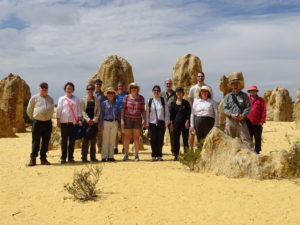Calibration / validation experts visit the WA desert – March 2019
From 25 to 29 March, CSIRO hosted a group of Earth observation researchers in Perth for the Committee on Earth Observation Satellites (CEOS) Working Group on Calibration Validation (WGCV) Infrared and Visible Optical Sensors (IVOS) Sub-Working Group Plenary meeting. The IVOS Mission is to ensure high quality calibration and validation of infrared and visible optical data from Earth observation satellites, as well as the validation of higher level products.
Topics discussed at the meeting include autonomous radiometric calibration, use of and comparisons of pseudo invariant sites, surface reflectance validation, reports on calibration and validation efforts for new and existing sensors, analysis ready data, pre-flight calibration, uncertainty characterisation, and, calibration using different methods including the moon.
The previous week, many of delegates visited the Pinnacles desert, CSIRO’s candidate Radiometric Calibration Network (RadCalNet) which will be instrument for autonomous vicarious calibration of optical sensors. The site is located approximately 200 kms north of Perth. Instrumentation to be installed in the near future includes radiometers, sunphotometers and meteorological instruments and other related data for vicarious calibration of satellite data. The Pinnacles desert is one of two terrestrial vicarious calibration sites in Australia contributing towards collaboration with international space agencies partners in return for access to Earth observation data for CSIRO and other Australian users.
Whilst here, the international visitors also took advantage of Western Australia’s lovely sunshine, beautiful beaches and unique wildlife (as well as kangaroos, koalas and emus, some had the chance to see the quokka!).

The IVOS team at the Pinnacles, near the desert cal/val site in Western Australia
